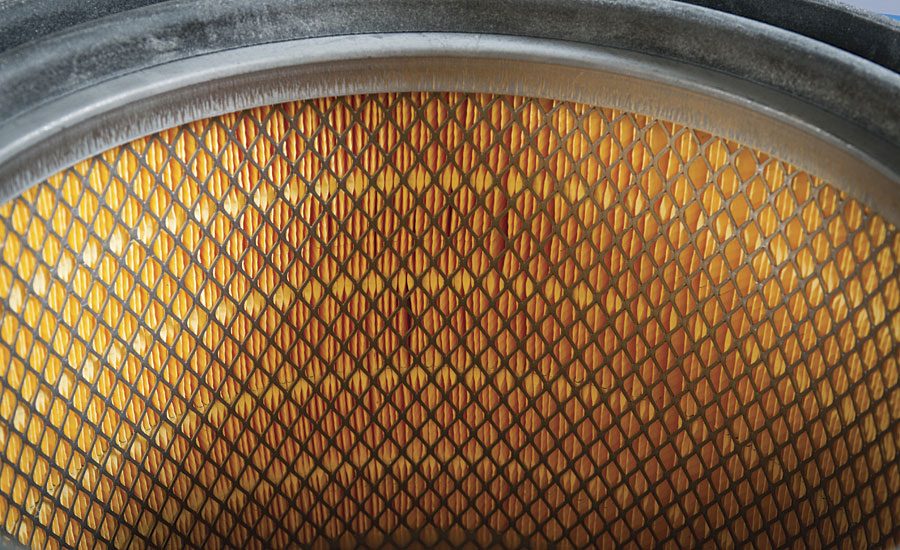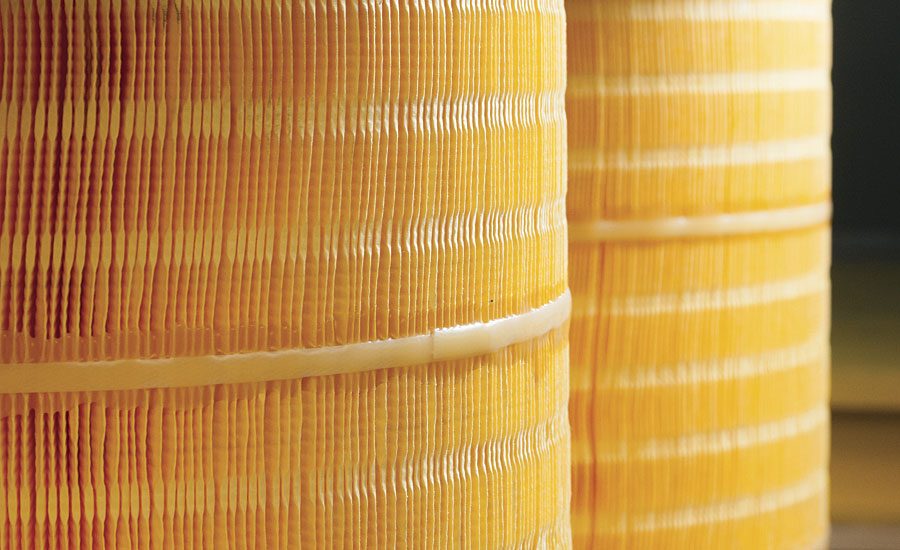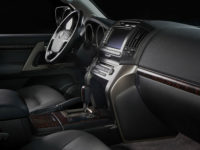Powder coating is efficient and durable. It is used on a wide variety of products. Compared to paints that contain solvents and volatile organic compounds, it is environmentally friendly and safer to use. However, there are situations where the airborne powder can be combustible. Because of this, NFPA rules do apply to these applications. Proper airflow and filtration is essential. Fortunately, there are options to help you achieve this.
Dave’s Story
Dave’s powder coating business had used an old booth for many years. It used square pocket filters made of a polyester mesh. As the business grew, though, Dave found that these pocket filters allowed too much dust to escape from the booth. They had also started to require more-frequent changes.
Dave was interested in installing a cartridge dust collector that would allow him to reclaim the powder he was using. Cartridge filters are very efficient, and because the powder is pulsed off the filter with compressed air, it can be reclaimed instead of getting stuck in the filter media.
The cartridge collector did a much better job of capturing all the loose powder and keeping it contained. However, Dave noticed that once in a while, static buildup inside the collector would cause sparks, creating a fire hazard.
Dave’s cartridge filters were fire-retardant, preventing them from catching on fire, but his attempts to ground the filters to get rid of the static didn’t work. Fortunately, cartridge filters come in a wide variety of media, and an expert can help find a solution to almost any problem. For Dave’s situation, the solution was a special media called aluminized spunbond. This polyester media with a metallized coating reduces static between filters and powder inside the collector. As an added benefit, spunbond is a durable material that can be cleaned with water, which would ruin a standard filter.
In addition to being more efficient than his previous filters, the new filters completely eliminated Dave’s issues with static and sparking in the dust collector.
Filters for Powder Coating
Dave’s situation might not sound like yours, but that’s because there are many different types of powder coating equipment and many different types of filters. Many new booths are installed or built with cartridge filters as part of the unit. Many older or smaller booths still use pocket filters, panel filters or cut-to-fit sheet material.
However, just because the powder used in powder coating isn’t as hazardous as solvent-containing volatile paints, it can be a fire and a health hazard. Powder coating falls under NFPA 33, the standard for spray applications of combustible materials, including powders.
Maintaining safe levels of airborne powder inside the spray area requires a high volume and velocity of air movement. The minimum is often set at 60 feet per minute (FPM), but FPM higher than 100 is recommended, especially for a booth. In a traditional powder recovery system, airflow in the ductwork must be high enough to keep dust from settling inside the ducts.
Cartridge filters are ideal for powder recovery. When they are located in a collector outside the unit, ductwork conveys the airflow through the collector. This air can be returned into the facility safely because of the high efficiency of cartridge filters. When they are built in as part of the booth, the air is usually exhausted to the outside of the booth.
Other filters commonly used include square pleated panel filters, polyester “pocket” filters, or cut-to-fit sheets of a variety of materials. The efficiency of these filters can vary greatly. The material can be cellulose, polyester, fiberglass or some other material.
Pocket filters and other woven media often develop holes or weak points that allow powder to leak through. They filter dust by capturing it inside the material, which means that when it is time to change them they are very messy.
Panel filters have much less surface area than a cartridge filter, and they can lose efficiency very quickly. Like pocket filters, they trap material in the filter media, and this dust slows down the airflow through the filters.
While the sheets of filter material are effective for covering a large area, they do not promote efficient airflow. They are also prone to leaking of powder around the edges and through small holes in the material. These sheets can also be messy and inconvenient to change, since they are dirty and full of powder.
All three of these filter types are often used as pre-filters for a cartridge filter system. They can effectively capture a lot of the dust before the air gets to the cartridge filters.
In many systems, especially powder reclaiming systems, there is a secondary filter, often a box-style filter. These are designed to capture any powder that gets through the primary system.
Cartridge Filter Systems
One major advantage of cartridge filters is that a cartridge system will pulse clean the filters with compressed air, keeping the filters clean. The pulsing removes dust from the outside of the filter. The advantage of cartridge filters is that they do not work by trapping dust in the filter media. Instead, the dust accumulates on the surface and is pulsed off.
Other types of filters usually collect the dust in the filter media. This means that they quickly become clogged with dust. It also means that changing them is often very messy. Cartridge filters will eventually accumulate enough dust to lower their efficiency, but because of the larger air-to-cloth ratio and the pulse cleaning, it usually takes much longer.
Cartridge filters come in several different types of material. The common lower-end material is 80% cellulose and 20% polyester, known as 80/20. These filters are not efficient enough for small particles to be a good solution for powder coating. They are popular in many applications because they are cheap, but low quality is not a wise investment, especially if you are reclaiming powder.
Nanofiber is a coating that is applied to a filter that lets it filter out much smaller particles. Nanofiber filters can handle the very small particles, so they are an option for powder coating. They can have up to a MERV 15 rating, generally the highest rating that can be found in a cartridge filter. This material has a long filter life, but will be ruined by contact with water or too much moisture.
Spunbond is one of the most popular materials for powder coating. The MERV rating is not as high as for nanofiber, but it is still efficient enough for powder coating particles. One advantage of spunbond is that it is very tough and durable. It can get wet without being ruined, unlike other cartridge filters. Spunbond polyester cartridge filters can have a variety of coatings, including static dissipating carbon or grounded aluminized material.
One disadvantage of spunbond is that these filters are generally not fire-retardant. While they can withstand higher air temperatures than many other filters, they will melt in a fire and are not an effective way of controlling a fire in a collector. However, since all powder coating booths are required by NFPA 33 to be equipped with a fire suppression system, this should not be a major issue.
We have found that the majority of our powder coating customers use spunbond filters because of their durability and the fact that they can be washed with water. However, customers should note that repeated washing can cause holes or leaks in the filter. It should also be noted that the filters will still eventually accumulate enough dust that they will have to be replaced. Washing spunbond filters repeatedly can lead to unseen holes that let powder escape out of the filtration system.
Cartridge Filter System Maintenance
Maintenance on cartridge collector systems is usually very simple, especially if the filters are inserted vertically. Because cartridges are pleated, they have much more surface area than other filters, and the compressed air pulse cleaning makes them last much longer. The efficiency of the filters is monitored with a differential pressure gauge. When the reading on this gauge exceeds the recommended level, it means that the filters can’t let air flow properly anymore and it is time to change them.
Because cartridge filters are cleaned by the compressed air pulses, they are not designed to be taken out and cleaned. Spunbond filters are more durable than others and can handle being cleaned a few times, but even this material will eventually be damaged and start to get holes in it.
Filters that are damaged by cleaning may not look damaged. The only way you may know there are holes might be when you notice powder leaking through. Filters should be handled according to the manufacturer’s instructions.
One problem with leaks in your cartridge filters is that this will put tremendous strain on the secondary filters, causing them to fail very quickly. If your secondary filters are failing before they should be, it may be because the primary cartridge filters are not sealed correctly at their gaskets or have holes in them.
Proper grounding of the powder coating equipment should prevent static charge from building up on the filters. However, in some situations static can be a problem in the dust collection system. Dave’s story is an example of this. If this is a problem, it can be solved by using spunbond filters with a special coating. Options include a carbon coating that keeps static from building up between filters, or an aluminized coating that makes sure the filters are properly grounded.
Dust Collection Options
While older and smaller booths may still be using pocket, panel or sheet filters, cartridge collectors are the choice for many manufacturers of new booths. They are definitely the choice for those looking to reclaim powder. The pulse cleaning of cartridge filters reclaims much more powder than other types of filtration. If your booth does not currently use cartridge filters, retrofitting with a small cartridge collector may be a worthwhile investment.
A manufacturer of quality cartridge filters like DeltaMAXX can help you determine whether cartridge filters are a good solution for you. They can also help you find the right filter for your needs.






Report Abusive Comment